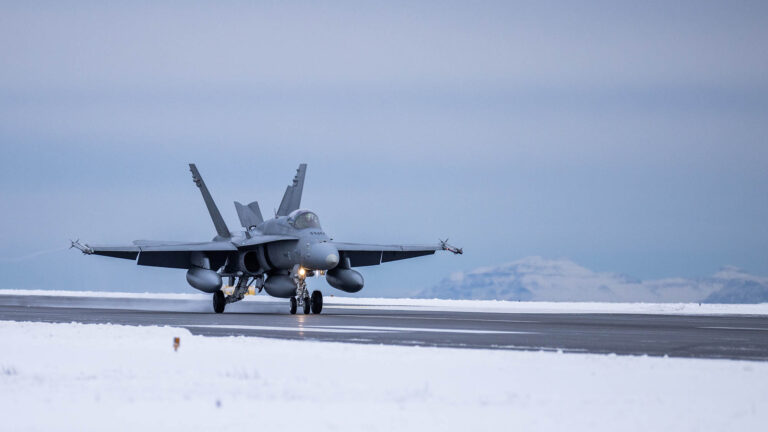Four Hornets touched down in Iceland on Jan. 24, 2025 for a three week detachment. It is the first time Finland has contributed to the Icelandic Air Policing mission since becoming a NATO member.
Fighter Squadron 11 of the Lapland Air Wing, usually based at Rovaniemi Airport, is providing the aircraft and most of the 50 personnel for the deployment. The squadron recently completed an extensive training program during Exercise Cobra Warrior 24-2.
Unlike the NATO Baltic Air Policing mission, Icelandic Air Policing is not a continuous mission, meaning that the Finnish F/A-18C Hornets will not directly assume the tasking from a previous force. The last unit to deploy for Icelandic Air Policing was 617 Squadron of the UK Royal Air Force, who provided the air defense service with F-35B Lightning IIs.
The detachment will be locally directed by the Control and Reporting Centre (CRC) at Keflavik, which oversees a network of four air defense radars located around the island nation. These remotely operated radar stations were constructed by NATO and funded by the U.S. Air Force until the withdrawal of permanent U.S. forces from Iceland in 2006. Today they are operated by the Icelandic Coast Guard, but they remain part of the NATO air defense network and are under the jurisdiction of the Combined Air Operations Center (CAOC) at Uedem, Germany.
.@NATO forces conducted operations in support of Icelandic Air Policing from the Control and Reporting Center at Keflavik Air Base, Iceland Oct. 26, 2020.
The CRC uses battle management to command and control all of the air operations for the IAP mission. pic.twitter.com/KcaECw0fLJ
— Airman Magazine (@AirmanMagazine) November 1, 2020
Iceland’s strategic location in the GIUK gap makes it an important outpost for NATO operations and a particular target for Russian intelligence activity, but as Iceland does not have its own air defense fighter capability it relies upon these NATO deployments. Previous Icelandic Air Policing deployments have intercepted a number of long-range Russian Air Force surveillance flights. The Quick Reaction Alert (QRA) jets are equally able to respond to other threats to Icelandic airspace, such as non-responsive or unidentified aircraft.
While the arrangement might appear somewhat one-sided in Iceland’s favor, in return NATO are able to utilize Keflavik as a hub for maritime patrol aircraft and a conveniently located stop-over or diversion point for certain trans-Atlantic transit flights. Communications infrastructure is also located at various locations around Iceland.
Since U.S. facilities at Keflavik were upgraded in 2017 followed by over a decade of minimal operations the airfield has even seen deployments of E-6B Mercury strategic communications aircraft and B-2A Spirit stealth bombers.
US Air Force maintainers prepare a B-2 Spirit for conventional munition loading as part of a Bomber Task Force mission at Keflavik Air Base, Iceland, Aug 18. pic.twitter.com/GCWvhcqqqU
— Ryan Chan 陳家翹 (@ryankakiuchan) August 22, 2023
While this deployment is Finland’s first on the Icelandic mission, their F/A-18C Hornets have previously deployed to Keflavik for exercises. Due to the climate of their home nation, they are also no strangers to the requirements of operating in freezing conditions. Finland has also already contributed F/A-18s to secure airspace around Vilnius, Lithuania for the July 2023 NATO Summit, and they conducted their first long-term NATO Baltic Air Policing deployment in Romania during 2024.


“The Norwegian and Danish Air Forces have regularly contributed to the Air Policing mission in Iceland, so this is a natural task for Finland as well. It is in line with Finland’s objectives that NATO has recognized the strategic importance of the High North” asserts Major General Timo Herranen, who has been Commander of the Finnish Air Force since Dec. 1, 2024.
When on alert status or active patrol, the F/A-18s will carry live missile and gun ammunition and be fitted with combat-ready self-protection systems. Operations will be conducted with the same techniques used for homeland air defense.
Þorgerður Katrín Gunnarsdóttir, Icelandic Minister of Foreign Affairs and leader of Viðreisn (Liberal Reform Party) marked the occasion by stating “The participation of Finland in the Icelandic Air Policing Mission is a significant milestone which demonstrates how Finland and Sweden‘s entry into NATO strengthens and deepens our defence cooperation and contributes to our security”.
Transition to F-35
Finland chose the Lockheed Martin F-35A Lightning II to replace its force of legacy F/A-18 Hornets in 2021, with the stealth fighter winning out over competition from the Saab Gripen E/F and the Boeing F/A-18E/F Super Hornet. The first of Finland’s 64 new jets entered production in 2024 and roll out is expected in Autumn 2025.
Forward progress for Finland’s first F-35! ⏩@FinnishAirForce Colonel (ret.) and F-35 project manager, Henrik Elo, visited our Fort Worth, TX, @LockheedMartin facility to sign the bulkhead of Finland’s first F-35, a major step towards delivering their first aircraft. pic.twitter.com/bDNXu6t7tZ
— F-35 Lightning II (@thef35) October 29, 2024
Rovaniemi Airport is due to receive its first F-35 delivery in 2026, followed by Kuopio Airport in 2028. This should see the Finnish Air Force convert entirely to the F-35 by the end of the decade. F-35s are expected to be operated by Finland into the 2070s.
The Hornets have been operated by the Finnish Air Force since 1992, when they replaced an interesting mixed fighter force of Swedish Saab 35 Drakens and Soviet Mikoyan Gurevich MiG-21s. Finland maintained a neutral stance during the Cold War and fostered working relationships with both the Western and Eastern Bloc, seeing equipment procured from NATO and Soviet manufacturers.
Modern times have seen Finland move dramatically towards NATO, culminating in the country joining the alliance after the Russian invasion of Ukraine. Despite this, Finland’s primary service rifle is still to this day a descendant of the famous AK-47, and the Finnish Army operates BMP-2 infantry fighting vehicles alongside Swedish-built CV90s. Soviet era T-55 medium tanks remained in service until only a number of years ago.



